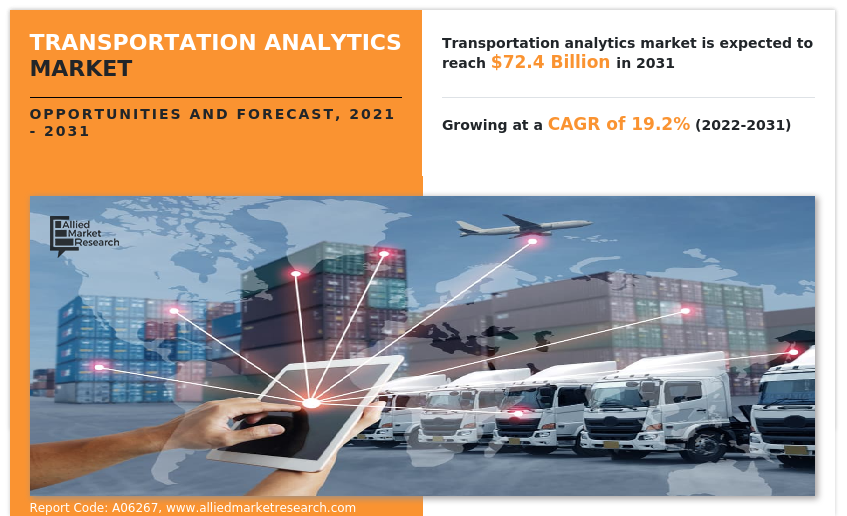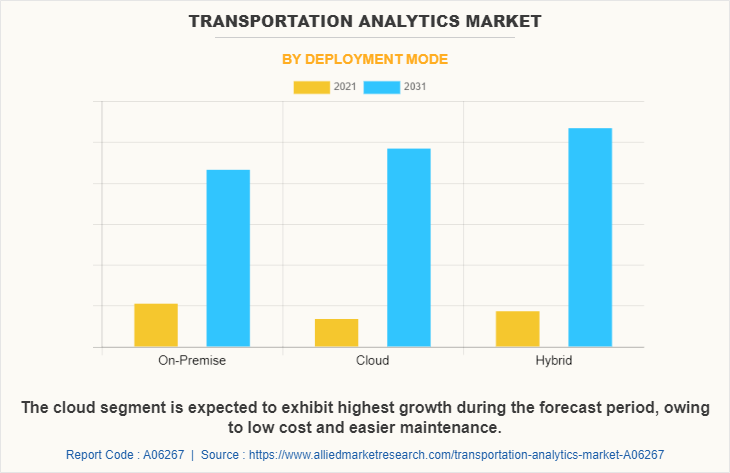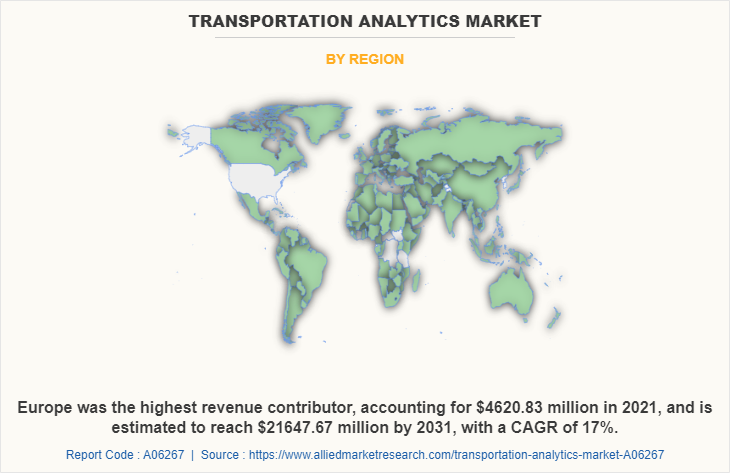Transportation Analytics Market Overview
The global transportation analytics market was valued at USD 12.9 billion in 2021, and is projected to reach USD 72.4 billion by 2031, growing at a CAGR of 19.2% from 2022 to 2031.
The transportation analytics deals with the immense amount of route data within distribution operation. Regardless of the size, it can guide to better business decisions that will ultimately benefit the operation. In addition, transportation analytics provides valuable metrics throughout all stages of the delivery process. It not only helps to learn about the company’s weakest and strongest points but also provides solid reports and deliverables, so the organization can share with clients. Such advantages provide lucrative opportunities for the transportation analytics market growth.

Furthermore, big data analytics is heavily used in supply chain management to evaluate operational hazards, improve communication, secure proprietary data, and improve supply chain accessibility. This data is used by industries in a variety of ways, including predictive analytics and the creation of more efficient cloud-based platforms. Data mining, statistics, and machine learning are used in predictive analytics to assess future supply demands, inventory, and customer behavior. Companies use predictive analytics and machine learning to forecast future physical hazards in the supply chain and financial, customer, and other operational risks, thus propelling the growth of the transportation analytics market.
The emerging transportation analytics trends meet the growing demand for autonomous operations, digitalization, and sustainability. The industry is increasingly adopting driverless vehicles. Startups develop semi and fully autonomous cars with advanced driver-assistance systems (ADAS), light detection and ranging (LIDAR), and computer vision. Drones, robots, and driverless trucks enable autonomous last-mile deliveries. Large-scale electrification solutions are accelerating the development of charging infrastructure and innovative batteries. Other transportation trends include innovative solutions that utilize artificial intelligence (AI), the internet of things (IoT), and blockchain deployed to optimize supply chain management.
In addition, businesses explore ways to automate logistic operations by adopting transport analytics solution & services, which drive the growth of the market. In addition, trends such as mobility-as-a-service (MaaS), and smart shipping also find numerous applications in the transportation industry. The focus is to not only improve the overall efficiency of transport operations but also to reach the ultimate goal of sustainability with minimum pollution. Thus, this provides lucrative opportunities for the market growth during the forecast period. The transportation analytics market is segmented into Type, Application, Mode of Transport, Component and Deployment Mode.
Segment Review
The transportation analytics market is segmented into component, deployment mode, type, application, mode of transport, and region. As per component, it is bifurcated into solutions and services. According to deployment mode, it is divided into on-premise, hybrid, and cloud. On the basis of type, it is categorized into predictive, descriptive, and prescriptive. Depending on application, the market is segmented into traffic and incident management, transit planning and maintenance, logistics management, and others. By mode of transport, it is categorized into roadways, railways, airways, and waterways. Region wise, it is analyzed across North America, Europe, Asia-Pacific, and LAMEA.

On the basis of deployment mode, the on-premise segment captured the largest market share in 2021 and is expected to continue transportation analytics market trends during the forecast period. This is attributed due to the numerous advantages offered by the on-premise deployment such as a high level of data security and safety. Industries prefer on-premise model owing to high data security and less data breach as compared to cloud based deployment models, which further drive the demand for on-premise deployment model within the sectors.
However, cloud segment is expected to exhibit highest growth during the forecast period. Factors such as rise in the adoption of cloud-based transportation analytics due to low cost and easier maintenance drives the growth of the market. In addition, it provides flexibility & scalability to boost business processes, which propels the transportation analytics market growth.

By region, Europe dominated the transportation analytics market share in 2021 for the transportation analytics market. This is due to increase in investment in transportation analytics solution for improving businesses and customer experiences is anticipated to provide lucrative growth opportunities for the transportation analytics market in Europe region. However, Asia-Pacific is expected to exhibit highest growth during the forecast period. This is attributed to increase in penetration of advanced technologies such as AI, ML, and increasing digitalization toward business processes, propelling the transportation analytics market forecast in this region.
Top Impacting Factors
Growing adoption of advanced technologies such as AI, ML, Internet of Things (IoT), Big Data, and Blockchain
Embracing advanced digital solutions in logistics and transportation industry can improve operational efficiencies and transparency in the sector by revamping existing business and creating a proactive business model. New-age digital logistics and transportation trends such as implementing technologies like artificial intelligence (AI), machine learning (ML), internet of things (IOT), big data, and blockchain will help businesses to keep pace with brimming competition.
Many organizations have now been benefited by implementing ML and AI in the transportation industry, which has helped them to gain a competitive edge over other players. Through these advanced technologies company can identify patterns and generate insights into the logistics and transportation process, which is also useful for predictive network management. These trends provide with real-time data and an unmatched level of transparency throughout the supply chain so that businesses can make informed decisions and enhance the customer experience. Such trends propel the growth of the transportation analytics market during the forecast period.
Advent of autonomous vehicles and drones
Optimizing the logistics and transportation network to handle last-mile deliveries is necessary for business growth. With more autonomy and capabilities in the vehicles, organizations can make the logistics operations cheaper, quicker, and safer. Advent of drones and autonomous vehicles is known to be the next generation of logistics business models. Drones can reduce the complex tasks by keeping an inventory check. Automated vehicles can enhance the driving tasks without human intervention. Therefore, these technologies tend to work for transporting goods between warehouses, eliminating the driving task, inventory counting inside large warehouses, and so on. Embracing new-age digital logistics trends can improve the operations and customer experience, thus driving the growth of the transportation analytics market.
Surge in adoption of digital twins’ technology
Digital twins are possibly one of the most exciting technologies for logistics and transportation industry. The potential use cases for digital twins in logistics are vast. In the shipment sector, digital twins can be used to collect product and packaging data and use that information to identify potential weaknesses and recurring trends to improve future operations. Warehouses and facilities can also use the technology to create accurate 3D models of their centers and experiment with layout changes or the introduction of new equipment to see their impact, risk-free.
Furthermore, logistics hubs are able to create digital twins and use those to test out different scenarios and increase efficiency. In addition to that, delivery networks could use the technology to provide real-time information that will improve delivery times and further aid autonomous vehicles in their routes.
COVID-19 Impact Analysis
The global COVID-19 pandemic has drastically affected businesses across the world. The transportation analytics market analysis has witnessed considerable growth in past few years; however, due to the outbreak of the COVID-19 pandemic, it is expected to provide lucrative opportunities for the market growth. This is attributed to implementation of lockdown by governments in majority of the countries and the shutdown of travel across the world to prevent the transmission of the virus. This has affected the supply chains of several industries.
However, the transportation analytics market is projected to prosper in the upcoming years after the recovery from the COVID-19 pandemic. In addition, various organizations have initiated adopting cloud-based transportation analytics solution to manage critical information of organizations as well as in manufacturing processes, thus creating lucrative opportunity for the market expansion during the forecast period.
Furthermore, increase in volume of data generated by different business processes and the need to manage this data are the key factors driving the growth of the transportation analytics industry. Moreover, transportation analytics rapidly empowers mobility information and insights, altering transportation planning by making vital data collection and understanding more accessible, faster, cheaper, and safer. Cities, transit agencies, transportation departments, and other entities increasingly turn to transportation analytics to solve challenges, prioritize investments, and gain stakeholder support which, in turn, drives the growth of the transportation analytics market.
Moreover, the monitoring technology has catapulted the business beyond simple track-and-trace data into a new world of supply chain visibility in just a few years. In addition, the use of fleet management technologies is also helping to improve transportation efficiency. Data is also allowing for more personalization and control in the transportation industry. Internet of Things (IoT) sensors in trailers now allow drivers and dispatchers to watch and report on temperature, humidity, movement, and other vital elements in real-time, allowing them to intervene before a problem arises.
By increasing transparency in the transportation business, digital freight platforms enable enterprises to think beyond today’s shipment. Due to such advanced technology, shippers may see regional trends, individual lane cost information, and driver preferences, while carriers can get specifics like loading/unloading durations and lane history data. All this information can aid in lowering operating costs without compromising service. Such benefits will provide lucrative opportunities for the transportation analytics market growth during the forecast period.
Although COVID-19 has severely impacted various industries, the transportation analytics market is expected to witness moderate impact of COVID-19, due to major shift toward digital transformation, increase in investments in data analytics, rise in adoption of AI and ML, advent of autonomous vehicles and drones, and surge in need for tracking real-time information. Such trends are expected to boost the market growth during the forecast period.
Key Benefits for Stakeholders
The study provides an in-depth analysis of the transportation analytics market along with the current trends and future estimations to elucidate the imminent investment pockets.
Information about key drivers, restrains, and opportunities and their impact analysis on the transportation analytics market size is provided in the report.
The Porter’s five forces analysis illustrates the potency of buyers and suppliers operating in the transportation analytics industry.
The quantitative analysis of the global transportation analytics market for the period 2021–2031 is provided to determine the transportation analytics market potential.
Transportation Analytics Market Report Highlights
| Aspects | Details |
| Market Size By 2031 | USD 72.4 billion |
| Growth Rate | CAGR of 19.2% |
| Forecast period | 2021 - 2031 |
| Report Pages | 312 |
| By Type |
|
| By Application |
|
| By Mode of Transport |
|
| By Component |
|
| By Deployment Mode |
|
| By Region |
|
| Key Market Players | IBM Corporation, TomTom International BV, Indra Sistemas, S.A., Siemens AG, Cubic Corporation, Kapsch TrafficCom AG, Trimble Inc., Alteryx, Inc., INRIX, Cellint |
Analyst Review
According to CXOs of the leading companies, over the time, businesses have seen various changes in the business processes, operations, and industrial automation. Moreover, businesses are shifting toward the digital platform and increasing implementation of Industry 4.0 to cope with ongoing tough business competition which creates the need for seamless solution to meet these requirements.
This increases eventually escalates the adoption of transportation analytics market. Furthermore, the transportation analytics market has boomed as artificial intelligence (AI) and machine learning (ML) technologies become more widely used in various sectors. The AI-driven technology empowers businesses to keep up to date with the latest data. These advantages provide lucrative growth opportunities for the transportation analytics market growth in the upcoming years.
Furthermore, increasing usage of sensor technology and IoT drive the growth of the market. The use of sensors can allow a department of transportation to identify bridges that require complete reconstruction and others that require only one or two new girders to replace those presenting structural issues. For instance, the South Carolina Department of Transportation has a Federal Highway Administration grant to evaluate the value of structural-health-monitoring technology to complement visual inspection. Another emerging use is in the railroad industry, where sensors monitor track geometry, rail corrugation, and track-surface measurements, facilitating maintenance and long-term investment decisions. Such enhancement provides the lucrative opportunities for the market growth in forthcoming years. On the contrary, the growth of e-commerce has led to higher expectations on speed, agility, and visibility.
Manufacturers, merchants, and consumers have pushed transportation and warehousing companies to develop quickly to meet ever-increasing service demands. Transportation management is evolving because of supply chain technology fueled by data and analytics. These practical tools aid businesses in being more educated, efficient, and long-lasting.
Nevertheless, prominent market players are exploring new technologies and applications to meet the increase in customer demands. Product launches, collaborations, and acquisitions are expected to enable them to expand their product portfolios and penetrate different regions. Emerging economies provide lucrative opportunities to market players for growth or expansion.
The global transportation analytics market was valued at USD 12.9 billion in 2021, and is projected to reach USD 72.4 billion by 2031
The global transportation analytics market is projected to grow at a compound annual growth rate of 19.2% from 2021-2031 to reach USD 72.4 billion by 2031
Alteryx, Inc., Cellint, Cubic Corporation, IBM Corporation, Indra Sistemas, S.A., INRIX, Kapsch TrafficCom AG, Siemens AG, Trimble Inc., and TomTom International BV.
Europe is the largest market for transportation analytics.
Factors, such as surge in adoption of predictive analytics in transportation industry, drive the growth of the market. In addition, increase in adoption of transportation analytics for ensuring better control of ground-level activities strengthens the growth of the market for future.
Loading Table Of Content...



